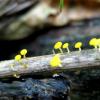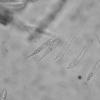
11-11-2025 20:16
Bohan JiaHi, lastly I have found these tiny yellow decayin

09-11-2025 13:20
Hello.A tiny ascomycete, appearing as erupting gra

08-11-2025 00:29
 Francois Guay
Francois Guay
I found this species in Quebec, Canada, on herbace

04-11-2025 09:07
Hello.A suspected Hymenoscyphus sprouting on a thi

04-11-2025 12:43
 Edvin Johannesen
Edvin Johannesen
Hi! One more found on old Populus tremula log in O
Disc yellowish, up to 2 mm., stalk whitish, smooth and slender.
Asci 142-160 x 12.8-14.4 microns, IKI+.
Ascospores 40-48.7 x 4.5-5.8 microns.
Paraphyses filled with refractive contents.
Ectal excipulum, parallel, thick-wall, gelatinous hyphae.
Is this a Crocireas?
I couldn't identify by Carpenter's monograph.
Best wishes,
Kutsuna

This is certainly a Hymenoscyphus in which the excipular cells are also somewhat gelatinized. Such strongly heteropolar spores are unknown in Crocicreas or Cyathicula.
This find is interesting, it reminds me of the N-American Hymenoscyphus dearnessii, a variant of which is known from Europe, here exclusively on Fallopia (Reynoutria). But the spores are not as big as you say, also they should have bristles at the ends.
Have you more microphotos? Ascus croziers? In which part of thw wordl did you collect, and what could the substrate be?
Zotto
Thank you for your reply.
This disco collected in bush near beech forest, Tottori, Japan, 22.Sept.2012.
Substrate uncertain herbaceous stem, I think Polygonaceae.
I have no more microphotos, but I couldn't observe coriziers and bristles.
Kutsuna

Yu et al. 2000, Mycotaxon 75: 395-408
This sounds like a new species.
Zotto
Kutsuna



 0401b-0001.jpg
0401b-0001.jpg